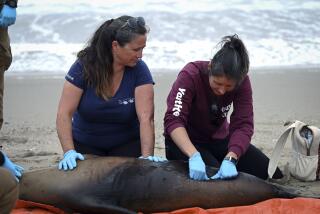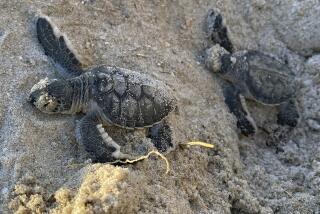Tumors a Threat to Sea Turtle Species : Epidemics: A plague has gone from being a minor problem five years ago to infecting half the world’s population.
- Share via
MARATHON, Fla. — The golf-ball-size growths, resembling moldy cauliflower, bulged from the green sea turtle’s head and body.
“You can see why it’s so hard to ignore,” said conservationist and Florida Keys motel owner Tina Brown as she held up the turtle, its eyes concealed by the grotesque fibropapilloma tumors.
Indeed, Brown and her boyfriend, Richie Moretti, have not ignored the mysterious ailment, which is baffling scientists and threatening to wipe out the species.
For the last few years, they have devoted part of their Hidden Harbor Motel, all of its proceeds and countless hours to finding the cause of the disease--and a cure.
The plague is so widespread that experts say at least half the green sea turtle population is suffering from fibropapilloma.
“We’ve seen it go from a minor problem in 1986 to something that’s just eating the turtles up,” said Moretti, 47.
Despite the widespread occurrence of fibropapilloma tumors, however, little was done to determine the cause until the last couple of years. Only a few scientists across the country are actively working on the problem.
First observed in the late 1920s, the disease has reached epidemic proportions in Hawaii and Florida, scientists at the National Marine Fisheries Service said. In the last few months, cases have been reported in Australia and the Caribbean Islands.
It was long believed to be a cosmetic affliction; veterinarians treated it by tying off the tumors. But the growths often reappeared.
Turtle experts believe fibropapilloma could be caused by a virus, a virus in combination with pollution, or by a parasite that either conveys a virus or causes the tumor directly.
The study received a boost in December when 10 scientists met in Hawaii to coordinate a national research plan.
“The timing of the workshop was critical,” said George H. Balazs, a zoologist with the Honolulu Laboratory of the National Marine Fisheries Service. “The number of reported cases of the disease is mounting, and the disease is spreading geographically.”
One focus of the fibropapilloma study is the marine research center Moretti and Brown, 33, have created out of an old saltwater swimming pool at their motel.
With the help of Elliott Jacobson, a veterinary sciences professor at the University of Florida, Moretti and Brown built the Marine Environmental Project last year.
Jacobson last year injected tumor cells into various parts of seven healthy turtles. They injected five other turtles with placebos. They hope to be able to isolate the virus that causes the tumors as it reaches the stage of transmission.
According to Jacobson, however, the disease has not been transmitted through the injections.
The scientific struggle is only one of the battles fought by researchers. Another is money.
“Up until recently, it wasn’t recognized as a very significant problem by government agencies,” Jacobson said. “I think everybody in a position of administrative responsibility had no idea the extent of this disease.”
Balazs said the problem may stem from a more general problem.
“Some of the frustrations are that diseases of reptiles do not seem to carry very high priority in any realm,” he said. “It’s sort of the ‘looking down your nose at lower animals and cold-blooded animals (attitude).’ ”
Jacobson said a cure is a long way off, even with greater success in the lab and better funding.
Undaunted, Moretti and Brown continue their mission. They’ve attracted a veterinarian to the motel to serve as a vet-in-residence, and are hoping to turn an old strip bar next door into a turtle hospital.
In five years, they’ve received about 150 turtles, some with birth defects, skin or shell injuries. More than 50% have suffered from papilloma, but only two have been returned to the wild.
To each reptilian patient they give care and respect, administering parasitic injections, turtle tracheotomies and IVs. And they syringe-feed malnourished turtles a concoction of creamed babyfood spinach, Gatorade, a glucose mixture and liquid vitamins.
More to Read
Sign up for Essential California
The most important California stories and recommendations in your inbox every morning.
You may occasionally receive promotional content from the Los Angeles Times.










